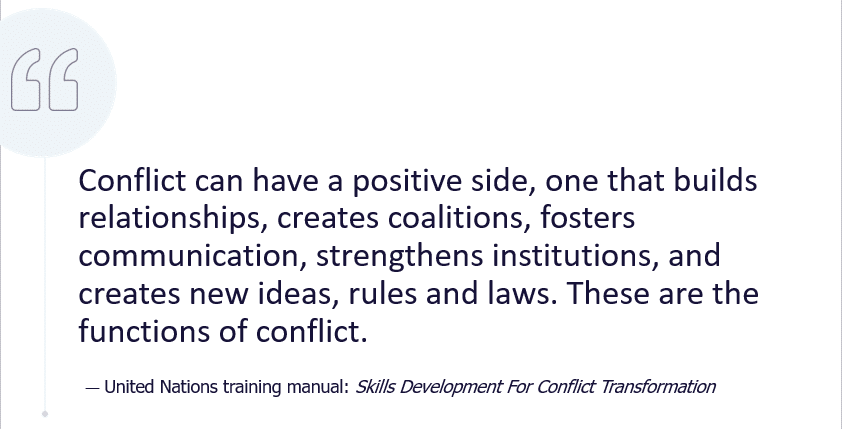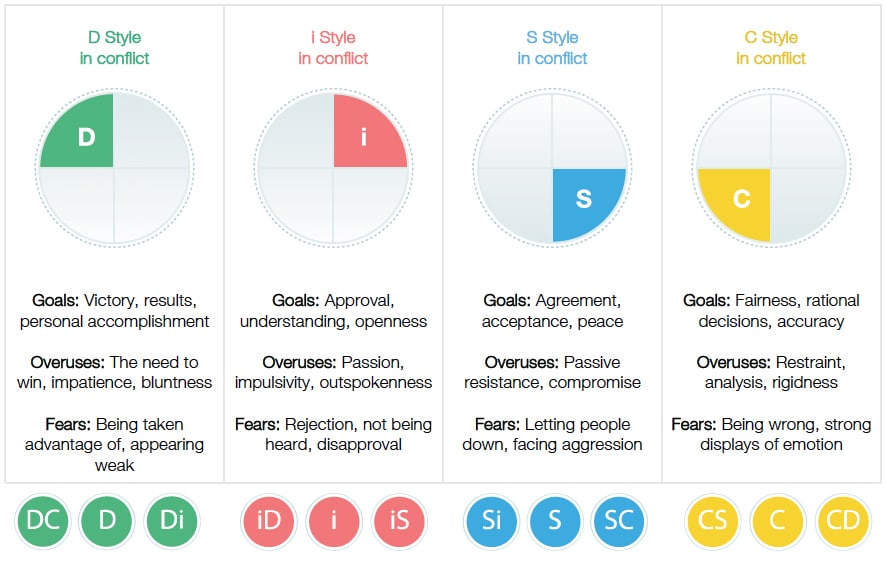Conflict is not always the sign of a dysfunctional team, Patrick Lencioni reminds us in The Five Dysfunctions of a Team. Artificial harmony is more dangerous. So how can you encourage your team to welcome conflict and not shy away from it?

Identify shared objectives
Make it a goal-driven debate rather than a personality conflict. Often conflict arises and remains present because there are no shared objectives, the objectives are unclear, or someone has a hidden agenda. Sometimes it’s exacerbated by someone introducing other issues to the debate. Stopping the discussion for a few minutes to agree upon what is being discussed and why it is important can refocus everyone’s thoughts. Referencing your objectives makes it clear that the debate is worth having even if it’s uncomfortable.
Never debate solutions until you are clear about the nature of the problem. Does this problem relate to the shared team objective? How? If the problem is actually about someone’s personal agenda, then the real issue might be about team commitment and accountability.
Agree that the debate is one worth having. It’s often easier to talk about a minor issue, like the color of an image, than about a real challenge to achieving your objective.
Use group facilitation skills
Summarizing and paraphrasing can also be helpful techniques anyone on the team can use to bring attention back to shared objectives. These facilitation techniques also reassure people that they have been heard. Restating what you hear as areas of agreement and areas of debate can refocus your discussion, keep it moving forward, or bring it to a close.
Watch your teammates’ body language. Is someone agreeing verbally, but looking bitter? Does someone else look entirely disengaged? Use facilitation skills to get these members talking and expressing what’s going on for them.
If the team is really struggling, consider bringing in an outside facilitator to assist with keeping the debate on track and productive. That way no one on the team has to take that process role and everyone can focus on the topic or issue.
Discuss styles of debating
Some people equate raised voices with passion. Others sense hostility when volumes rise. Can the group agree on a set of behaviors they want to see everyone use during debate?
Review your DiSC styles, Five Behaviors Team Development conflict map, or other assessments. Discuss how each personality type deals with conflict and how you see that played out on your team. What are your team’s rules of engagement?

Teams might have to acknowledge that they need to practice having healthy conflict within the group. What counts as a debate and what would they consider a fight? They might need to go back to working on trust among members. Share examples of what each member thinks is worth fighting for.
Confront passive-aggressive behavior. Is there someone on your team who agrees to a decision and then seems to sabotage it? Do you bite your tongue and agree to work on something, and then just can’t make yourself deliver? Passive-aggressive behavior can spring from unspoken conflict. It’s much easier to wrestle with a conflict in the open. But how do you bring it to the surface?
Someone on the team needs to call out possibly disagreeable issues early in a discussion. What are the possible areas of disagreement? Has everyone spoken to those issues? Is someone trying to gloss over conflict? Are you able to sit with the feelings that come up during a heated discussion? Are you able to express them?
I suggest reading “Why Work Is Lonely” (Harvard Business Review) to reinforce understanding why not speaking up is not the same as being polite. The author calls it “violent politeness.”
Beware of personal comments
Placing blame or playing the victim can derail productive conflict. It can also erode trust within the team. Blaming is different from holding someone accountable. It’s the difference between making a generalized comment about a person and making a specific observation about a behavior that affects the team. In other words, attack the problem, not the person.
Avoid leaving the conflict
It can be tempting for some people to avoid the discomfort of a temporary conflict by ignoring it. Team members need to be alert to others who seem to be withdrawing from the discussion and welcome them back in. It helps to remind the entire team that conflict is productive and that they have raised important questions and made insightful observations. Sometimes a group of relatively silent members all nodding slightly or looking bored might mean that fundamental issues have not made it to the table. (It can also mean that it’s time to take action instead of continuing debate.)
Watch for lazy or delusional consensus
Sometimes it just feels easier to agree and move on. It’s also easy to fall into a cognitive or relationship bias. There are several psychological traps we can all fall into, such as the anchor trap. That’s where a chart, price, or statement is seen first, and all subsequent judgments are made in relation to it, instead of in relation to your entire knowledge base. For example, you might plan to repeat an employee engagement activity again this year without stepping back to review current needs and schedules. Or a team that is used to one person typically making good decisions might have a hard time questioning his or her next one.
Celebrate the fruitful results of conflict
Share your appreciation when someone brings a difficult issue to the surface. Share what you learned during a debate. Review the behaviors that led to successful results. Engaging in productive conflict can give your team an advantage by increasing learning, creativity, and innovation; encouraging real collaboration; and achieving long-lasting results. It’s worth celebrating.

